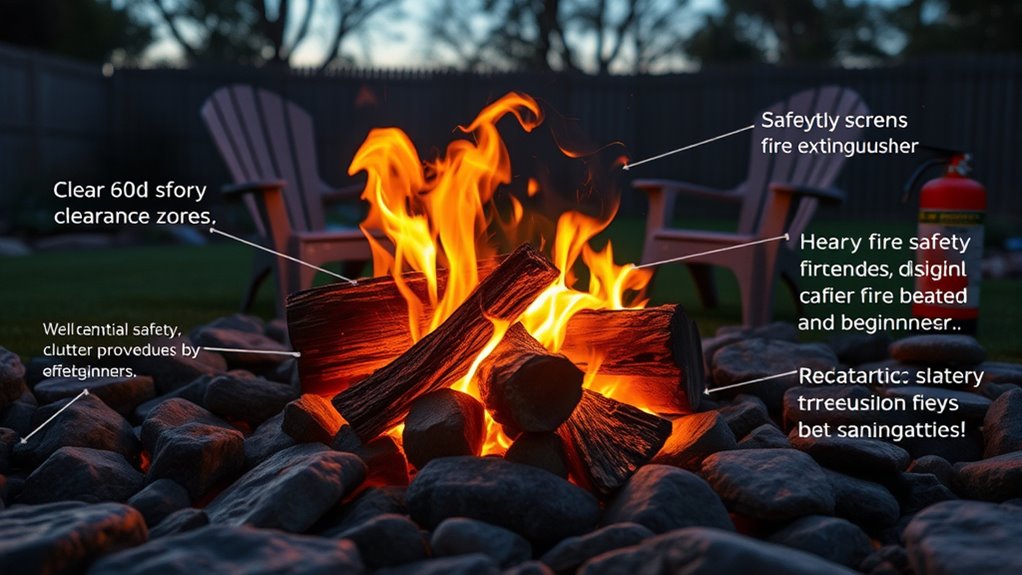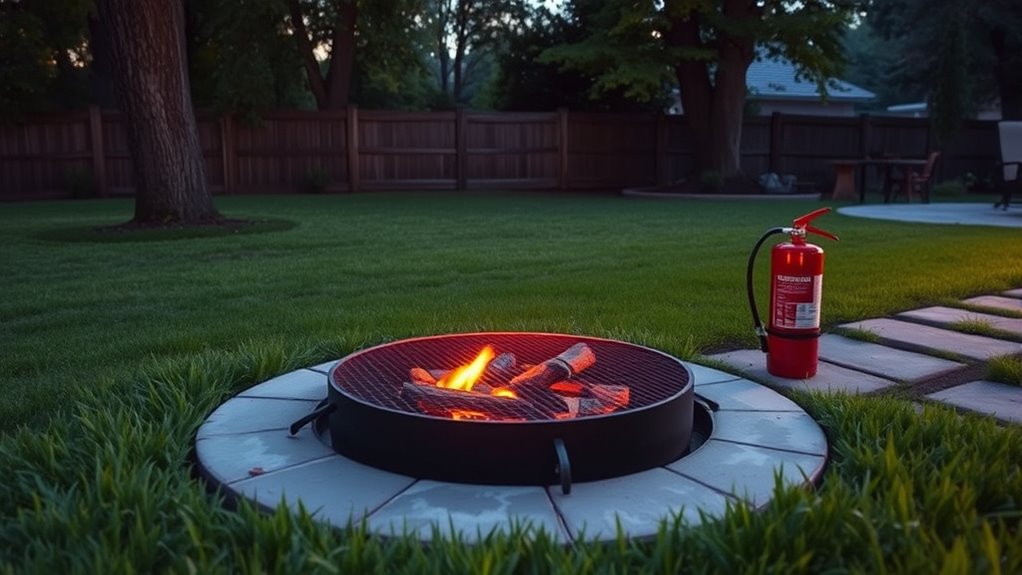When setting up your fire pit, most beginners overlook proper placement—keeping it at least 20-25 feet from structures and on non-flammable surfaces—and don’t always check local regulations. They may forget to use a spark screen, keep a water source nearby, or always supervise the fire. Avoid burning trash or accelerants, and never leave a fire unattended. If you want to stay safe and enjoy your fire pit responsibly, there’s more to grasp before lighting that first flame.
Key Takeaways
- Many beginners overlook proper distance from structures and flammable materials, increasing fire risk.
- Failing to use a spark screen or keep fire extinguishing tools nearby can lead to uncontrolled fires.
- Beginners often neglect weather conditions, such as wind or dry seasons, which heighten fire hazards.
- Not supervising the fire at all times or leaving it unattended is a common safety oversight.
- Improper disposal of ashes and not ensuring the fire is fully extinguished can cause lingering fire dangers.

A fire pit can be a great addition to your outdoor space, but safety should always come first. Proper placement is essential to prevent accidents and damage. You should position your fire pit at least 20 to 25 feet away from your house, fences, or trees. While some sources suggest a minimum of 10 feet, local regulations may have specific requirements, so always check your area’s codes before installing. Make sure your fire pit sits on a level, non-flammable surface—never place it on a combustible deck unless it’s specifically designed for wood-burning fires. Leave about 7 feet of clearance around the fire pit for seating and safe movement, avoiding cramped spaces that could lead to accidental contact with flames or hot surfaces. Always verify local regulations for placement rules, as these can vary considerably depending on where you live. Additionally, understanding mammography guidelines can help you stay proactive about your health, especially if you have risk factors for breast cancer. Starting and maintaining your fire safely is equally important. For gas fire pits, open the propane valve slowly, use a long lighter, and keep your hands away from the flame during ignition. If you’re using wood, begin with a tinder bundle and arrange kindling in a pyramid shape to promote good airflow. Leave a small gap for adding more tinder if necessary. Commercial fire starters can help you ignite quickly and with less smoke, but never pour accelerants like gasoline—they produce toxic fumes and can cause uncontrolled flames. Keep a close eye on the fire at all times, especially during windy conditions, and never leave it unattended. Unsupervised fires can quickly become hazardous. Fire control measures are essential for safe enjoyment. Use a spark screen to contain embers and prevent sparks from escaping. Keep a water bucket, garden hose, or fire extinguisher nearby for emergencies. Avoid burning treated wood, plastics, or trash, as these emit toxic fumes. Using a fire pit grate improves airflow and helps ensure cleaner, more efficient burns. When seating around the fire, make sure everyone stays at a safe distance to avoid accidental contact with flames or hot surfaces. Weather plays a key role in fire safety. Never light a fire during high winds, as embers can travel and ignite nearby materials. Before igniting, check for overhanging branches or flammable structures. During dry seasons or burn bans, refrain from building fires. Always monitor weather changes and extinguish the fire if conditions worsen. Clear away dry grass, leaves, or mulch from the area to reduce fire risk. Supervision is non-negotiable. Never leave a fire pit burning unattended and keep children and pets at a safe distance. Clearly mark the fire pit area to prevent trips or falls and establish rules for safe behavior around the flames. Educate everyone on fire safety basics and emergency procedures to ensure everyone knows how to respond if needed. Finally, always extinguish the fire completely before leaving. Use a snuffer lid to smother flames and embers, or pour water slowly and evenly if necessary. Stir the ashes to ensure no hot embers remain and dispose of cooled ashes in a metal container away from combustibles. Regularly inspect your fire pit for damage, clear debris, and check gas lines for leaks if using propane. Proper maintenance and cautious practices will keep your fire pit safe for many enjoyable evenings.
Frequently Asked Questions
Can I Leave My Fire Pit Unattended Overnight?
You shouldn’t leave your fire pit unattended overnight. Even small embers can reignite or cause a wildfire if not fully extinguished. Always supervise your fire and guarantee it’s completely out by pouring water over the embers, stirring, and checking for heat or smoke before leaving. Leaving a fire unattended, especially overnight, increases the risk of accidents, property damage, or wildfires—so it’s safest to extinguish it thoroughly before sleeping.
What’S the Best Type of Wood for Fire Pits?
The best wood for fire pits depends on what you want. Hardwoods like oak, ash, cherry, and maple burn longer, produce less smoke, and give consistent heat, making them ideal. They also create fewer sparks and are safer for prolonged fires. Softwoods ignite quickly and look great but burn faster and produce more smoke. For a safe, enjoyable fire, stick with seasoned hardwoods for sustained, cleaner flames.
How Close Can Furniture Be Placed to a Fire Pit?
You can place furniture about 18 to 24 inches away from your fire pit to guarantee safety and easy access. Keep larger pieces like sofas facing the fire for warmth and ambiance, while chairs should be angled for comfortable viewing. Avoid placing furniture too close to prevent accidental contact with flames or heat. Remember, maintaining proper clearance balances safety with enjoying the cozy atmosphere your fire pit creates.
Are There Specific Clothing Materials to Avoid Near Fire Pits?
You should avoid wearing flammable fabrics near fire pits, like nylon, acrylic, silk, and untreated cotton, which can catch fire or melt quickly. Instead, choose fire-resistant materials such as treated polyester, wool, or leather with fire retardants. While natural fibers can be risky, treated cotton offers some safety if handled properly. Always prioritize safe, non-flammable fabrics to prevent accidents and enjoy your fire pit responsibly.
How Do I Extinguish a Fire Pit Safely?
To extinguish your fire pit safely, stop adding fuel and let the flames die down naturally or turn off the gas supply if it’s a gas fire pit. Use a garden hose on a shower setting to slowly sprinkle water over the ashes, stirring to cool completely. Avoid pouring water quickly, and double-check that all embers are cool before leaving. Always prioritize caution to prevent accidents or damage.
Conclusion
Remember, safety isn’t about ruining the fun—it’s about enjoying your fire pit responsibly. Even if you’re new to it, taking simple precautions keeps everyone safe and your evenings stress-free. Don’t let worries hold you back; just stay attentive, keep a fire extinguisher nearby, and enjoy cozy nights outside. With these tips, you’ll create memories around your fire pit without any unexpected mishaps. Fire responsibly, and let the good times roll!









